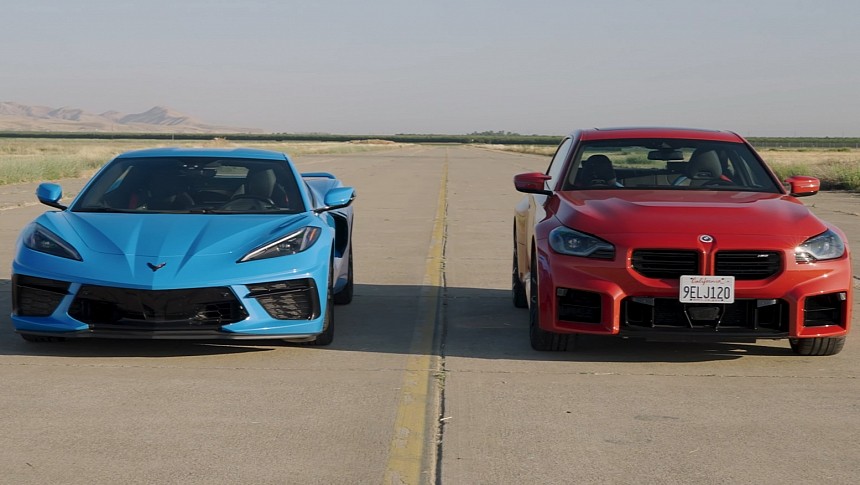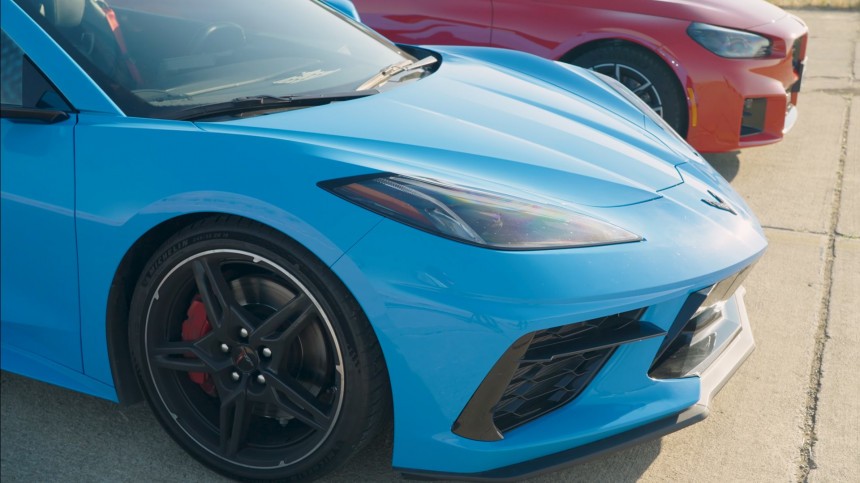What happens when you take one runway and race a 6.2-liter 2020 Chevy Corvette Stingray against the 3.0-liter 2023 BMW M2? Well, you get a show well worth watching. The kicker is that while it's not entirely fair to race a 6.2-liter engine against a 3.0-liter one, there's no denying that for these cars, value-wise, it makes more than enough sense.
First off, the rules are a bit different from your average 1/4-mile standoff. They're not all that different, but they put a really nice spin on things. The key word here is "spin."
The fine folks over at the "Edmunds Cars" YouTube channel made the term "U-drag racing" somewhat popular. The purpose is quite simple. Two drivers in high-end cars sprint toward the 1/4-mile mark, make a U-turn, and then come back to the starting line as fast as possible.
This way, the vehicles are being put to the test in every way deemed fit for the public roads. You have acceleration, braking, turning, and handling. Now, let's meet our contestants.
First, we have the gorgeous 2020 Chevrolet Corvette Stingray. This rear-wheel drive 8-speed automatic blue gem comes with a 6.2-liter V8 engine that can output 495 hp (502 ps) with 470 lb-ft (637 Nm) of torque. The 'Vette weighs 3,649 lbs., and this particular model is worth close to $81,000.
The 2024 Stingray model comes in at $68,300 MSRP and can go from 0 to 60 in 2.9 seconds with a top track speed of 194 mph. Corvette also boasts that it can finish the 1/4-mile in 11.2 seconds.
On the other side of the track, we have the 2023 BMW M2 with a very controversial-looking front-end. Some think the "nostrils" are too small, and others believe they aren't small enough... it's an entire debate.
The M2 is RWD as well, and it's powered by a 3.0-liter straight-six engine that can deliver 453 hp (459 ps) with 406 lb-ft (550 Nm) of torque. It's just a bit heavier than the Stingray, weighing in at 3,860 lbs. On paper, it should hit 60 in 4.2 seconds. This model costs almost $67,000, and in comparison, the 2024 BMW M2 has an MSRP of $63,200.
As you very well guessed by now, the 6.2-liter Corvette Stingray won both events with ease and grace. The 2020 Stingray went from 0-60 mph in 3.5 seconds, while the M2 did it in 3.9 seconds. Far from the officially stated 4.2 seconds, but still not nearly fast enough to close the gap.
For the 1/4-mile, the Corvette comes out on top again with 11.6 seconds on the clock, flying at 118.4 mph. The BMW wasn't that far behind here and finished in 11.8 seconds at 119.9 mph.
Overall, the Chevy finished in 34 seconds flat at 127.9 mph, and the M2 in 35.2 seconds at 128.4 mph. While the gap between them isn't anything to be scared about, at the end of the day, the Stingray won in one department where the "Beamer" has no chance of catching up: looks and style.
The fine folks over at the "Edmunds Cars" YouTube channel made the term "U-drag racing" somewhat popular. The purpose is quite simple. Two drivers in high-end cars sprint toward the 1/4-mile mark, make a U-turn, and then come back to the starting line as fast as possible.
This way, the vehicles are being put to the test in every way deemed fit for the public roads. You have acceleration, braking, turning, and handling. Now, let's meet our contestants.
First, we have the gorgeous 2020 Chevrolet Corvette Stingray. This rear-wheel drive 8-speed automatic blue gem comes with a 6.2-liter V8 engine that can output 495 hp (502 ps) with 470 lb-ft (637 Nm) of torque. The 'Vette weighs 3,649 lbs., and this particular model is worth close to $81,000.
The 2024 Stingray model comes in at $68,300 MSRP and can go from 0 to 60 in 2.9 seconds with a top track speed of 194 mph. Corvette also boasts that it can finish the 1/4-mile in 11.2 seconds.
On the other side of the track, we have the 2023 BMW M2 with a very controversial-looking front-end. Some think the "nostrils" are too small, and others believe they aren't small enough... it's an entire debate.
As you very well guessed by now, the 6.2-liter Corvette Stingray won both events with ease and grace. The 2020 Stingray went from 0-60 mph in 3.5 seconds, while the M2 did it in 3.9 seconds. Far from the officially stated 4.2 seconds, but still not nearly fast enough to close the gap.
For the 1/4-mile, the Corvette comes out on top again with 11.6 seconds on the clock, flying at 118.4 mph. The BMW wasn't that far behind here and finished in 11.8 seconds at 119.9 mph.
Overall, the Chevy finished in 34 seconds flat at 127.9 mph, and the M2 in 35.2 seconds at 128.4 mph. While the gap between them isn't anything to be scared about, at the end of the day, the Stingray won in one department where the "Beamer" has no chance of catching up: looks and style.


